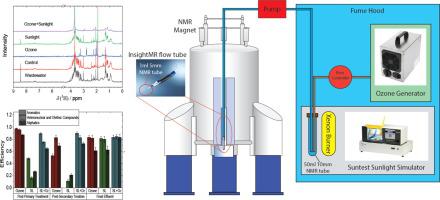Chemical Engineering Journal ( IF 13.3 ) Pub Date : 2020-08-18 , DOI: 10.1016/j.cej.2020.126696 Bing Wu , Rudraksha D. Majumdar , Daniel H. Lysak , Rajshree Ghosh Biswas , Maryam Tabatabaei-Anaraki , Amy Jenne , Xiang You , Ronald Soong , Daniel Lane , Paul A. Helm , Anna Codina , Venita Decker , Myrna J. Simpson , Andre J. Simpson

|
Wastewater contains complex organic signatures, whose components can be harmful to both environmental and human health. Nuclear Magnetic Resonance Spectroscopy (NMR) is an excellent tool for molecular monitoring, with ability to follow total organics, subcategories (aromatics, aliphatic etc.) and, resolution permitting, even individual compounds. However, due to the relatively low sensitivity of NMR, studies of wastewater to date have involved preconcentration (often many liters) before analysis. This proof of concept study asks, “Is NMR sensitive enough for online wastewater monitoring without preconcentration?” Here, a continuous flow 500 MHz NMR system, coupled with a sunlight simulator and ozone generator, was used on unaltered and unconcentrated wastewater to assess the potential of on-line NMR for understanding wastewater treatment processes. Wastewater from 3 different treatment stages were analyzed. In general, combined ozone and sunlight was more effective at removing organics, while differences in behavior of the same molecules within different wastewater fractions suggest that the chemistry is more complex than just the action of “reactants” (light, ozone) on the target chemicals, and to some extent, involves other components in the wastewater. As such, the nature of the effluent itself could also have important impacts on the rate and completion of its degradation. In summary, on-line NMR of wastewater treatment could be carried out without preconcentration of the wastewater, inline with important future applications for understanding wastewater treatment processes at the molecular level. Over the last decade, there has been considerable development in low field, low footprint, low cost, NMR spectrometers. Portable versions of those systems could potentially, in the future, be applied for onsite, online monitoring of waste streams at water treatment plants, as described here.
中文翻译:

进行废水处理的实时动力学监测:以流式NMR对未浓缩废水进行日光和臭氧处理的案例研究
废水中含有复杂的有机信号,其成分可能对环境和人体健康都有害。核磁共振波谱(NMR)是分子监测的出色工具,具有跟踪总有机物,亚类(芳族化合物,脂肪族化合物等)的能力,并允许分辨甚至单个化合物。但是,由于NMR的灵敏度相对较低,迄今为止,对废水的研究涉及分析之前的预浓缩(通常为数升)。这项概念验证研究问道:“对于在线监测废水而无需预先浓缩,NMR是否足够敏感?” 在此,将连续流500 MHz NMR系统与阳光模拟器和臭氧发生器结合使用,以处理未改变且未浓缩的废水,以评估在线NMR在理解废水处理过程方面的潜力。分析了3个不同处理阶段的废水。总的来说,臭氧和阳光的结合能更有效地去除有机物,而同一分子在不同废水级分中的行为差异表明,化学反应比“反应物”(光,臭氧)对目标化学物质的作用更为复杂。 ,并在一定程度上涉及废水中的其他成分。这样,废水本身的性质也可能对其降解的速率和完成产生重要影响。总而言之,可以在不对废水进行预浓缩的情况下进行废水处理的在线NMR,这与将来在分子水平上理解废水处理过程的重要应用相一致。在过去的十年中,低场,低占地面积,低成本的NMR光谱仪。如本文所述,这些系统的便携式版本将来可能会用于水处理厂的废水在线现场监控。





















































 京公网安备 11010802027423号
京公网安备 11010802027423号